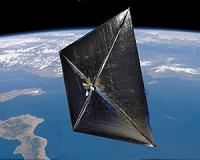 |
Santa Clara CA (SPX) Jan 21, 2011 Redfern Integrated Optics has announced that it has been awarded a Phase 1 SBIR contract for further development of its breakthrough single-frequency narrow-linewidth semiconductor laser, suitable for spaceflight operation. RIO is the leading supplier of low noise external cavity lasers and subsystems for the security, structural health monitoring, wind energy, clean oil and gas exploration and production, and metrology markets. RIO's proprietary external-cavity semiconductor laser technology is based on the hybrid integration of an InP gain chip and a planar lightwave circuit (PLC) with Bragg gratings. Packaged in a standard 14-pin compact "butterfly" package, the laser performance is characterized by a single-frequency output in the 1550nm spectral region with a linewidth less than 2kHz, low phase noise, low relative intensity noise (RIN), high immunity to vibrations, all under a wide range of operating temperatures. "The well-recognized performance and reliability of our laser was instrumental in its selection by NASA as the prime candidate for deployment in upcoming space missions," said Dr. Radu Barsan, chairman, president and CEO of RIO. "Already qualified to Telcordia standards and deployed in volume in the field in LIDAR and fiber optic sensing applications, RIO's semiconductor laser is uniquely suited for space qualification." RIO's PLANEX, ORION, and RIO-Grande lasers are ideal solutions in multiple applications where absolute accuracy, lifetime reliability over demanding field conditions, and high resolution are critical. Such applications include remote sensing, distributed temperature, strain, or acoustic fiber optic monitoring, high resolution spectroscopy, LIDAR and other precision metrology applications.
Share This Article With Planet Earth
Related Links Redfern Integrated Optics Space Technology News - Applications and Research
 NASA Seeks Amateur Radio Operators' Aid to Listen for NanoSail-D
NASA Seeks Amateur Radio Operators' Aid to Listen for NanoSail-DHuntsville AL (SPX) Jan 20, 2011 On Wednesday, Jan. 19 at 11:30 a.m. EST, engineers at Marshall Space Flight Center in Huntsville, Ala., confirmed that the NanoSail-D nanosatellite ejected from Fast Affordable Scientific and Technology Satellite, FASTSAT. The ejection event occurred spontaneously and was identified this morning when engineers at the center analyzed onboard FASTSAT telemetry. The ejection of NanoSail-D als ... read more |
|
| The content herein, unless otherwise known to be public domain, are Copyright 1995-2010 - SpaceDaily. AFP and UPI Wire Stories are copyright Agence France-Presse and United Press International. ESA Portal Reports are copyright European Space Agency. All NASA sourced material is public domain. Additional copyrights may apply in whole or part to other bona fide parties. Advertising does not imply endorsement,agreement or approval of any opinions, statements or information provided by SpaceDaily on any Web page published or hosted by SpaceDaily. Privacy Statement |